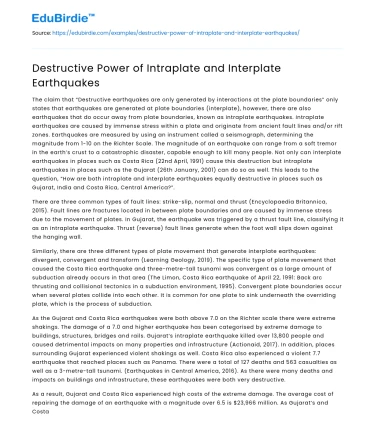The claim that “Destructive earthquakes are only generated by interactions at the plate boundaries” only states that earthquakes are generated at plate boundaries (interplate), however, there are also earthquakes that do occur away from plate boundaries, known as intraplate earthquakes. Intraplate earthquakes are caused by immense stress within a plate and originate from ancient fault lines and/or rift zones. Earthquakes are measured by using an instrument called a seismograph, determining the magnitude from 1-10 on the Richter Scale. The magnitude of an earthquake can range from a soft tremor in the earth’s crust to a catastrophic disaster, capable enough to kill many people. Not only can interplate earthquakes in places such as Costa Rica (22nd April, 1991) cause this destruction but intraplate earthquakes in places such as the Gujarat (26th January, 2001) can do so as well. This leads to the question, “How are both intraplate and interplate earthquakes equally destructive in places such as Gujarat, India and Costa Rica, Central America?”.
There are three common types of fault lines: strike-slip, normal and thrust (Encyclopaedia Britannica, 2015). Fault lines are fractures located in between plate boundaries and are caused by immense stress due to the movement of plates. In Gujarat, the earthquake was triggered by a thrust fault line, classifying it as an intraplate earthquake. Thrust (reverse) fault lines generate when the foot wall slips down against the hanging wall.
Save your time!
We can take care of your essay
- Proper editing and formatting
- Free revision, title page, and bibliography
- Flexible prices and money-back guarantee
Similarly, there are three different types of plate movement that generate interplate earthquakes: divergent, convergent and transform (Learning Geology, 2019). The specific type of plate movement that caused the Costa Rica earthquake and three-metre-tall tsunami was convergent as a large amount of subduction already occurs in that area (The Limon, Costa Rica earthquake of April 22, 1991: Back arc thrusting and collisional tectonics in a subduction environment, 1995). Convergent plate boundaries occur when several plates collide into each other. It is common for one plate to sink underneath the overriding plate, which is the process of subduction.
As the Gujarat and Costa Rica earthquakes were both above 7.0 on the Richter scale there were extreme shakings. The damage of a 7.0 and higher earthquake has been categorised by extreme damage to buildings, structures, bridges and rails. Gujarat’s intraplate earthquake killed over 13,800 people and caused detrimental impacts on many properties and infrastructure (Actionaid, 2017). In addition, places surrounding Gujarat experienced violent shakings as well. Costa Rica also experienced a violent 7.7 earthquake that reached places such as Panama. There were a total of 127 deaths and 563 casualties as well as a 3-metre-tall tsunami. (Earthquakes in Central America, 2016). As there were many deaths and impacts on buildings and infrastructure, these earthquakes were both very destructive.
As a result, Gujarat and Costa Rica experienced high costs of the extreme damage. The average cost of repairing the damage of an earthquake with a magnitude over 6.5 is $23,966 million. As Gujarat’s and Costa Rica’s earthquakes were above a magnitude of 5.5, the expenses listed above would have been a challenge faced by both economies due to the similar extremity of destructiveness. The total cost of repairing the damage from the Gujarat earthquake was $1.77 billion dollars. Similarly, Costa Rica had to pay a high cost of $160 million. As both of these earthquakes had a magnitude above 6.5 and were obliged to pay above the average cost - $23,966 million, these earthquakes had detrimental impacts on their economies.
In summary, by thoroughly analysing and investigating the evidence presented to answer the question, “How are both intraplate and interplate earthquakes equally destructive in places such as Gujarat, India and Costa Rica, Central America?”. It can be concluded that despite these earthquakes being generated differently from each other, they both had detrimental impacts on society, the economy and the environment. As a result, this does not fully support the claim that “Destructive volcanic activity and earthquakes are only generated by interactions at the plate boundaries”. If some of the evidence was gathered from a wider range of countries and is more specific and detailed, the conclusion would ultimately be more reliable and trustworthy.






 Stuck on your essay?
Stuck on your essay?

